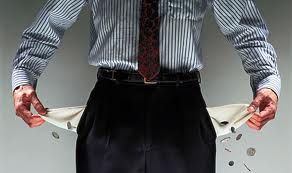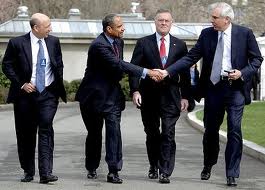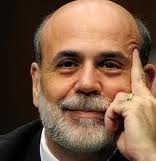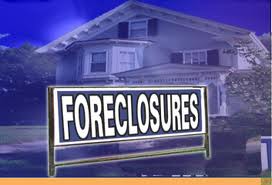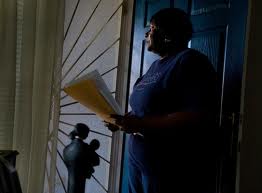Breaking Down the Real Cause of the Foreclosure Crises
The bankers say that the people losing homes simply aren’t able to make their payments. They all bought homes they couldn’t afford and now must to lose them to foreclosure. They were clearly “irresponsible borrowers, who never should have done what they did. That they are losing their homes to foreclosure is simply the natural order of things. JPMorgan Chase CEO, Jamie Dimon has even said that he considers foreclosure a form of debt forgiveness… almost a gift really.
So, the bankers want the country to believe that the proximate cause of the economic crisis was the bad loans, a point of view which quickly deteriorates into the completely unproductive debate over whether the bad loans were the fault of borrower or lender… sort of a financial version of “you got your chocolate on my peanut butter ““ you got your peanut butter on my chocolate.”
It’s a debate, however, that’s easy to understand and therefore has homeowners involved on both sides. What makes an “irresponsible borrower?” A jet ski in the garage and a flat screen in the den just about covers it… you’re an irresponsible borrower. If there’s a Hummer in the driveway, it’s the trifecta of irresponsibility and someone yells out, “Get a rope!”
Meanwhile, homeowners that find themselves at risk of foreclosure react to this debate in large part by feeling ashamed, unable to speak out for fear of being branded an “irresponsible borrower.” Those at risk of foreclosure go for months or even years without telling a soul… not their closets friends or family members… one husband I interviewed, hid the situation from his wife through 14 sale dates before finally getting the loan modified.
Homeowners caught up in today’s economic nightmare, of course, place the blame squarely on the bankers and mortgage servicers. They say they’re being foreclosed on illegally. They say that their banks have lied, broken the law and their promises, failed to follow any of the rules.
And then there are those that blame the crisis on financial innovation’s complex products, the increasing amount of leverage employed by commercial and investment banks, and the repeal of laws that deregulated banks and financial institutions, and left unregulated the market for derivatives, allowing for transactions to be increasingly opaque. To this group, it’s as if the crisis was caused by anything but human beings.
Lastly, there’s the president and other politicians who, when discussing the cause of the economic crisis, have basically employed the catchall phrase that places blame on no one… and everyone: “There’s plenty of blame to go around.” It’s almost as if the crisis were some sort of natural disaster akin to “the perfect storm.”
In the earliest days of the crisis, during the fall of 2007, before most Americans had any idea of what had happened, much less of what was to come, Ben Bernanke referred to sub-prime loans as being the source of the problem. He even surmised that the problem would be contained within the sub-prime sector. He was wrong on both counts, however, it wasn’t a sub-prime problem at all, in fact soon we would see than 54% of foreclosures would be prime loans, and the only place to which the problem would be contained was on planet Earth.
In ex-Treasury Secretary Henry Paulson’s book describing his experience during the last two years of the Bush administration, “On the Brink,” when talking about those early days in the fall of 2007 when he and Federal Reserve Chairman Ben Bernanke still saw the problem as being caused by sub-prime loans, he admits, “We just plain got it wrong.”
But, it’s the debate between the banks who blame “irresponsible borrowers,” and the borrowers who blame the banks that has become so entrenched in our lexicon that today it divides our nation, preventing our legislature from doing anything that one side perceives as a bail out of “irresponsible borrowers.” And as a result… the flood of foreclosures continues unabated, and as of May 2011, home prices nationally have fallen for the last 57 months in a row.
So, what really happened? Was it borrowers being irresponsible… all of a sudden?
Before answering the question as to whether irresponsible borrowers actually played a role in causing the financial and/or foreclosure crisis, consider what’s happened and is continuing to happen. We’ve lost millions of homes… and by that I mean 7-8 million homes with a couple million more having received default notices. Forecasts for the next three years vary, but most show that we’ll have roughly twice than many before we say Happy New Year in 2014.
In 2014, it will be seven years since the meltdown began in the summer of 2007, and something in the neighborhood of 15 million homes will have been lost to foreclosure. And there’s no reason to believe that foreclosures would stop at that point… why would they stop of their own volition?
Foreclosures, as I’ve said so many times it’s getting tiresome even for me, breed more foreclosures as they continue to put downward pressure on home values. Declining prices keep new borrowers on the sidelines, knowing they will only get a better deal if they wait. The lower home values impact entire neighborhoods. More people, hopelessly underwater… give up and walk away. People spend less on their homes and on themselves, corporate profits lag, layoffs continue and fewer jobs in turn create even more foreclosures. Some areas, as we’ve already started to see in parts of Las Vegas or Detroit, become little more than worthless empty slums.
Consider the following:
According to a presentation given at the 2011 – Federal Reserve Research Conference, foreclosures have steadily climbed in each of the last four years. In 2004 the foreclosure rate was 1.1%. By 2010, that rate was 203% higher, and today’s foreclosure rate is 131% higher than in 2007.
According to DoctorHousingBubble, the California of 2005 saw 50,000 Notices of Default. Last year the state had 300,000. In the California of 2006 the entire state had 12,000 foreclosures all year. In 2010, the number of foreclosures topped 171,000.
Nationally, banks repossessed 404,000 properties in 2007, and more than twice that number in 2008. Foreclosure filings in 2008 were 81% higher than in 2007. Then 2009 saw 21% increase in foreclosure filings over the prior year, and 918,000 properties repossessed. In 2010, we broke the one million mark for repossessed homes, so… spingle!
And from 2007 to today, American wealth has declined by 21%… that’s $13.8 trillion in American money. Home prices, between 1928 and 1933 fell by 25.9%, but the Case Schiller 10-city composite and 20-city composite data shows that since 2006, home prices have fallen by 32%. We didn’t see wealth evaporate or home prices fall that quickly during the Great Depression.
Of course, it doesn’t look like the Great Depression… no one is standing in soup lines. But, in 2005 there were roughly 11 million on food stamps and today that number is just over 44 million… one out of every seven Americans now on food stamps… 13.1 percent higher than last year at this time. That’s one hell of a soup line, of you ask me.
So, what happened? Is it really possible that 15 million people from all over the country… all of a sudden and from out of nowhere… all became “irresponsible” at around the same time and all ran out and bought homes they couldn’t afford? Is that even possible? All 15 million got irresponsible essentially at once?
Come on… that’s just silly, right? Did someone put something in the water?
And what about the banks? Was it just coincidental that every major bank in this country also became insolvent just as the foreclosure crisis began? And if it was bad loans that caused the banks to fail, shouldn’t they be worse off now, as the foreclosures have increased? But they’re not, are they? No, I guess they’re not.
You see, it wasn’t irresponsible borrowers that caused the crisis, in fact truth be told, irresponsible borrowers hardly mattered at all, as far as our financial crisis is concerned.
What happened, in simple terms, is that beginning in 2003, Wall Street discovered that it could buy something called a Credit Default Swap (a credit derivative, in banker parlance), not just on a triple-A rated corporate bond, but also on a triple-A rated mortgage-backed security. And that meant that certain investors on The Street could now bet against the mortgage-backed bonds that were starting to sell like hotcakes. The Credit Default Swap swapped the risk of the bond defaulting… in other words, it paid off if the bond it was essentially insuring, went bad.
The cost of a Credit Default Swap that would insure a $100 million bond was about $2 million a year for 10 years, according to Michael Lewis in his book, “The Big Short.” That’s 50 to 1, which is even better than the roulette wheel in Las Vegas. But it’s even better when you know the bond you’re betting against is going to default, right? I’ll say it is.
So, as Wall Street continued to pump air into the housing bubble, they didn’t just want regular old sub-prime loans, they wanted really bad sub-prime loans… they had gotten really good at the securitization game and by 2005 anything could be turned into a triple-A rated mortgage-backed security, which could then be bet against by someone who bought the other side of that bond, or the credit default swap (CDS).
As more and more Americans are coming to understand every day, things got fairly out of control from there and banks even loaded up their own balance sheets with the complex derivatives, called CDOs and CDOs squared… along with synthetic CDOs and those squared too. And since American real estate was simply never going down, in the eyes of many Wall Street bankers, they borrowed against their holdings, just like a homeowner in the late 1990s might have taken out a second mortgage to invest the money in the stock market, only bankers call it “leverage.” And for the ones that knew that thinking was goofy-tunes, they could go short, betting on the housing market’s demise, as counter-parties holding CDSs.
Everything was going according to plan until in July 10, 2007, Standard & Poors and Moody’s held a press conference in London at which they announced that they would be downgrading the ratings on 1,032 bond offerings backed by sub-prime mortgages… less than 1% of the bonds backed by sub-prime loans that had been issued at that time. But investors panicked. If these bonds were now being downgraded, what about all the others that they had feasted on the last few years?
Investors dumped bonds overnight and at fire sale prices, as everyone started wondering whether the insurers that had issued the CDSs would be able to pay their bills. Banks stopped trusting each other, because no one knew who had what on their balance sheet. New accounting rules, FAS 157 and 159, adopted in the fall of 2006 and often called the “mark-to-market” rules were forcing banks to write down their assets to market price each quarter.
And as the market for the CDOs et al, dried up, their value went straight off a cliff, like at the end of the movie, “Thelma and Louise.”
The credit markets, within just a few weeks, were frozen solid like an Alaskan lake in the dead of winter, and Fed Chair Ben Bernanke turned on the sirens and ran for the fire hoses and started pumping liquidity into the system to avert a total collapse. (It’s interesting that just two weeks before this happened, the Fed’s meeting had seen none of this coming.)
On August 10, 2007, PBS News Hour’s, Jeffrey Brown interviewed two “experts” in global finance, Laurence Meyer, a former Federal Reserve Board Governor, and Glenn Hubbard, who was at the time, Chairman of the President’s Council of Economic Advisers. It had been two days since the Federal Reserve and EU Central Banks had pumped $326 billion into the global financial system, and PBS was asking why.
JEFFREY BROWN: All together, central banks have pumped some $326 billion into the global financial system in the past 48 hours. Why don’t you explain what the Fed, other central bankers are doing? What does it even mean to pump extra cash into the financial system? Where does that money come from, and where does it go?
LAURENCE MEYER: Well, it creates deposits at the Federal Reserve by lending, by lending to these primary dealers, for example.
JEFFREY BROWN: Primary dealers meaning…
LAURENCE MEYER: Large banks and broker-dealers.
Doesn’t that exchange make you wonder why Lawrence Meyer didn’t just say that the $326 billion was being pumped into large banks and Wall Street broker-dealers, instead of saying “it creates deposits at the Federal Reserve by lending to primary dealers?”
JEFFREY BROWN: So that, what, so they can lend to each other? What is the problem that they’re trying to fix?
LAURENCE MEYER: So they can lend to each other, and so that they can, more generally, so that the lending can take place between banks and other institutions who lend to each other in the money market. And what happened was that that got disrupted because of a very abrupt re-pricing of risk in the economy. They became less willing to lend to each other.
You see… banks wouldn’t lend to each other because no one knew who was solvent and who had leveraged themselves across a bridge too far. And “disrupted because of a very abrupt re-pricing of risk in the economy.” Abrupt re-pricing of risk is just another way of saying that bond ratings were lowered overnight.
JEFFREY BROWN: Mr. Hubbard, explain more about this idea risk and re-pricing of risk. I think it sounds simple, but it’s at the heart of what we keep talking about in all of this. Explain it a little more for us.
GLENN HUBBARD: Well, exactly. I think many economists believe that risks had not been accurately priced in recent times, that risk premium “” that is, the spread you would get for bearing risk “” were very, very low by historical standards.
What we’ve seen is a pricing where the risky assets would now require much higher rates of return. We saw this in this market for so-called subprime mortgages, but it’s really filtered throughout markets for risky debt into higher-grade mortgages and into the leveraged loan market.
Did you read that last sentence carefully? We saw it in so-called sub-prime mortgages, but it has really filtered throughout markets into high-grade mortgages and leveraged loans? Hmmm… I guess “irresponsible sub-prime borrowers buying homes they couldn’t afford” didn’t cause the crisis after all… what do you know about that?”
That’s right… back then as the crisis began, no one was talking about irresponsible sub-prime borrowers, they were talking about the bond markets… or, the credit markets… you see money had stopped a-flowin’.
Banks started hoarding cash, the secondary mortgage market closed its doors, and the chances of getting a mortgage of any kind went from 100% to essentially zero. Predictably, as homes sat on the market longer and longer… home prices started to fall fast. The bubble had actually popped a year before during the summer of 2006, by which time Greenspan had raised interest rates 17 times in a row. But now, with credit tighter than Rush Limbaugh’s cycling shorts, there would be some that simply wouldn’t get out alive.
The foreclosure crisis had begun in earnest.
It was the fall of 2007 when Bernanke started talking about sub-prime loans being the cause of the foreclosure crisis, and had he been even close to right, we’d have been through with it by now. And perhaps, had 2008 not been an election year, with an unpopular Republican president and two Democratic party candidates fighting it out to the bitter end… perhaps under different circumstances we might have handled things differently… better, maybe.
(NOTE: JUST BELOW IS A LINK TO A PAPER BY PHILIP SWAGEL…Chief Economist at Treasury during the last two years of the Bush Administration. He wrote it for Brookings about six months after his job had ended. It’s fascinating… to me, anyway. So, I thought I’d share.)
Spring 2009 Philip Swagel Paper
But the 2008 presidential race was on, and the Dems were not of a mind to do anything that might help ole’ Dubya look good. So, when Bear Stearns went down in the Spring of that year, and Paulson contacted Speaker Pelosi, he was told not to sow his face on Capitol Hill unless he could guarantee there was a crisis at the door. And so… that’s what he did… waited until there was a crisis at the door… remember?
Paulson and Bernanke jumping in a car and putting the siren on all the way to Congress where they proceeded to tell everyone that the sky was falling and it was falling fast? You remember that day, right? I think just about everyone does… it was a few days before TARP’s $700 billion was approved after failing to pass the first time out. We were in bailout mode.
But it wasn’t homeowners we were bailing out… it wasn’t Main Street either. No, it was the banks that we were going to rescue, or so we thought. We didn’t have the political grit to stop foreclosures, which had already fueled a free fall in home prices, because that would have meant bailing out “irresponsible borrowers.”
We were going to bail out the “irresponsible bankers” instead.
And many in the American middle class turned their backs on those who were now at risk of foreclosure, saying that they deserved their fates, as unemployment rose into double digits and home prices sank by the same. We can’t reward their bad decisions, was the way most of this country talked about homeowners in financial distress, as we proceeded to do precisely that for our inconceivably irresponsible bankers.
And now here we sit. In homes we may never be able to sell, watching each quarter as their value declines, many still saying that we can’t bail out irresponsible homeowners, but nowhere near as loudly as we once said those same words. Soon, that cry will have become a whisper, as trillions more are drained from our collective middle class wealth.
Here we are a full three years later, and our government is the only lender to speak of, and with a nationalized… yes, they’ve been nationalized… Fannie and Freddie set to lower their lending limits and FHA just flat out broke. The average credit score for a Fannie loan for the last two years topping 763, and we might care if we weren’t so far underwater it just doesn’t matter. Besides, even if we weren’t, who would buy now, with prices falling and picking up speed and plenty more foreclosures ahead?
Today, the foreclosure crisis has spread from coast-t-coast. What was once a sunbelt state problem is now something seen in almost every state in the union. I recently watched Mr. Case, of Case Schiller fame be asked a question on television:
“Foreclosures in Minneapolis are up 26% year over year… what’s causing that?” The show’s host wanted to know.
Mr. Case replied, “I’m not sure, I’d have to study that.”
I walked calmly to my bathroom to throw up. “Study this, moron,” I said under my breath.
So, a lot of people wonder where we’ll go from here. We’re back to a presidential election year, during which we’ll debate Barack’s birth certificate, Obama-Care, immigration, and the funding of Planned Parenthood and NPR. And Obama will campaign among us once again, telling us with a smile that prosperity is right around the corner If we just stay the course.
The foreclosure crisis will hardly be mentioned, and those affected by it will remain at home, silent, ashamed and afraid to come outside except perhaps to vote, or pretend that everything’s going to be just fine.
Parents will pace the floors of homes they can’t stand the thought of losing. Mothers-to-be will cry gripped by the fear of not knowing for sure where they’ll live if the bank doesn’t approve their loan modification. And children will go through another year afraid, unsure of what’s happening around them, unable to fully understand why it doesn’t feel safe like it used to feel, and wanting to spend more time with parents who have no choice but to work 60 hour weeks and longer as they try everything to save their family home.
And fathers will sit at dining room tables wondering if their life insurance policies will pay off after suicide… and some will take their own lives… as the campaign rages on, with the rallies and the cheering… the confetti and the promises soon to be broken against the realities of American politics. And nothing will happen, nothing will change… and it will be 2013 when we once again start wondering when the free fall in home prices will stop.
By then… by the winter months of 2013, millions more homes will have received foreclosure notices, millions more homeowners will have mysteriously emerged from nowhere to become part of the “irresponsible borrower class.”
And millions more homes will have been taken back by the bank, only to sit as REOs in the shadow inventory, like old movie props, deteriorating for no reason except that we simply can’t bail out those irresponsible homeowners who we see as being so different from the rest of us… until it becomes us in financial trouble… and then we tell no one, choosing to suffer in silence in order to hold onto our dignity.
They made bad decisions, but we didn’t. They bought too much house, not us. They probably have a jet ski and a flat screen… quick take a peek in their garage. They made their bed, now they must lie in it. Hah!
We, on the other hand, just need a little help to get through this. We’ve never missed a payment before… we had perfect credit… you see, what happened was…
And sometime in the next couple of years, we’ll all come to realize that “it” isn’t coming back, and if “it” ever does, it’ll be thirty years before it does… too late for most of us to care. And we’ll settle into to whatever the fallen economy has left for us. And we’ll try to blame someone else for what’s happened. But we will have seen the enemy… and it was us.
And all because of the “irresponsible borrowers” that never were.
Mandelman out.


